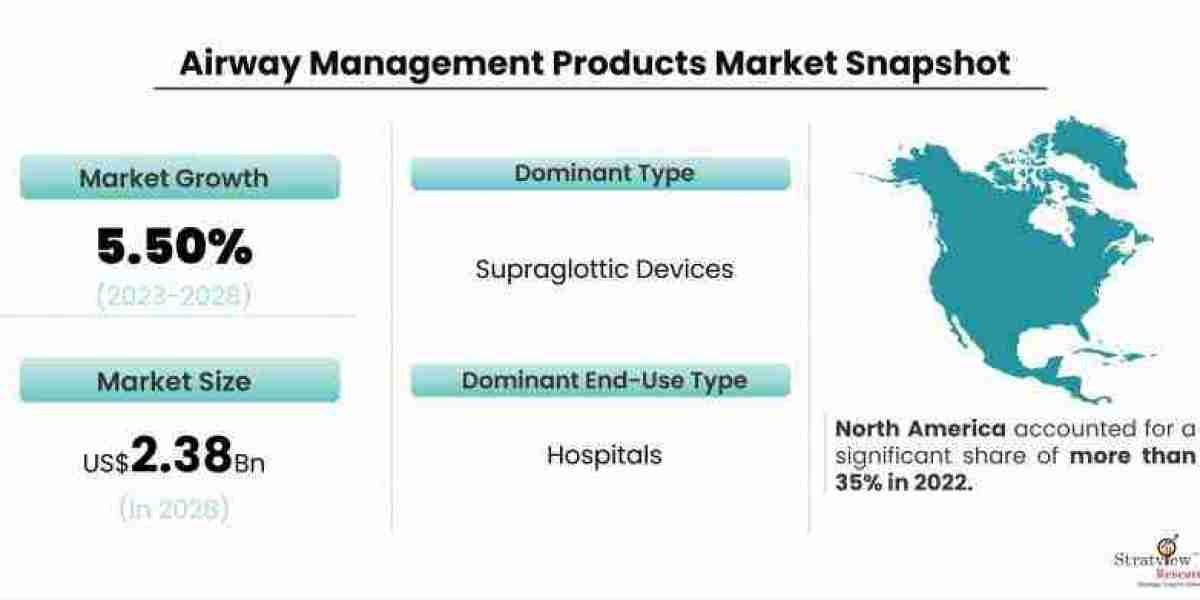Airway management is a critical aspect of healthcare that ensures adequate oxygenation and ventilation for patients. With the rapid advancement of technology, innovative solutions are revolutionizing the field of airway management. From augmented reality visualization to advanced monitoring systems, these technological innovations are reshaping the future of airway management, improving patient outcomes, enhancing healthcare provider skills, and optimizing overall patient care. The airway management products market is estimated to grow from USD 1.72 billion in 2022 to USD 2.38 billion by 2028 at a healthy CAGR of 5.50% during the forecast period.
Enhanced Visualization Systems:
Technological advancements have led to the development of enhanced visualization systems in airway management. Augmented reality (AR) and virtual reality (VR) technologies provide healthcare professionals with immersive and realistic views of the patient's airway anatomy. These systems allow for precise identification of anatomical landmarks, enhancing accuracy during intubation and other airway interventions. Furthermore, integrated camera systems and video laryngoscopes offer real-time visualization and recording capabilities, enabling healthcare providers to review procedures, assess technique, and provide feedback for continuous improvement. Enhanced visualization systems not only improve patient safety by minimizing complications but also provide valuable educational resources for training and skill development in airway management.
Intelligent Airway Devices:
The future of airway management lies in intelligent airway devices that incorporate advanced technologies to optimize patient care. Smart supraglottic airway devices equipped with sensors and real-time feedback systems can monitor airway seal pressure, cuff inflation, and patient ventilation parameters. These devices provide healthcare providers with instant data and alerts, enabling prompt adjustments and interventions to maintain optimal airway management. Additionally, the integration of artificial intelligence (AI) algorithms enables intelligent decision support, assisting healthcare professionals in making informed clinical decisions. Intelligent airway devices not only enhance patient safety and outcomes but also contribute to reducing healthcare provider workload and enhancing overall efficiency in airway management.
Remote Monitoring and Telemedicine:
The rise of telemedicine has had a profound impact on various aspects of healthcare, including airway management. Remote monitoring systems allow healthcare providers to monitor patients' airway parameters, such as oxygen saturation and end-tidal carbon dioxide levels, from a distance. This technology facilitates early detection of airway compromise or respiratory distress, enabling timely interventions. Telemedicine platforms also enable real-time video consultations between healthcare providers, allowing remote guidance and expert opinions during complex airway management procedures. Remote monitoring and telemedicine not only enhance patient access to specialized care but also provide valuable support to healthcare professionals in resource-constrained settings or during emergencies, ultimately improving patient outcomes and expanding the reach of airway management expertise.
Simulation-Based Training:
Simulation-based training has emerged as a valuable tool in airway management education and skill development. Advanced simulators and virtual reality systems provide healthcare professionals with realistic scenarios to practice airway interventions and refine their techniques in a safe and controlled environment. These training platforms offer interactive feedback, performance metrics, and the opportunity for repeated practice, enabling healthcare providers to enhance their skills without compromising patient safety. Simulation-based training also promotes team collaboration and communication, allowing multidisciplinary healthcare teams to train together and improve coordination during critical airway management scenarios. By integrating technology into education and training, simulation-based platforms revolutionize the learning experience, ensuring competent and confident healthcare providers in airway management.
Integration of Data and Analytics:
The future of airway management involves the integration of data and analytics to drive evidence-based practices. By collecting and analyzing airway management data, healthcare professionals can identify patterns, trends, and outcomes. This information can be utilized to develop best practices, refine protocols, and make informed decisions regarding airway interventions. The integration of electronic health records (EHRs) with airway management systems allows seamless data transfer and comprehensive patient information for personalized care. Furthermore, data analytics and machine learning algorithms can assist in risk prediction, early detection of complications, and customized treatment plans. The integration of data and analytics holds great potential in optimizing patient outcomes and advancing the field of airway management.
Conclusion:
Technological innovations are reshaping the future of airway management by enhancing visualization systems, introducing intelligent devices, enabling remote monitoring and telemedicine, revolutionizing simulation-based training, and integrating data and analytics. These advancements hold tremendous potential in improving patient safety, enhancing healthcare provider skills, and optimizing overall patient care. As technology continues to evolve, the future of airway management looks promising, providing innovative solutions that will undoubtedly transform the landscape of healthcare and pave the way for improved airway management practices.








